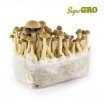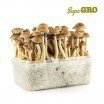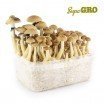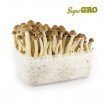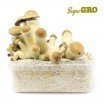Don't have an account?
Register NowYou have to add to cart at least 5 bottles or any program to make checkout.
- BlogThe History Of Magic Mushrooms
The History Of Magic Mushrooms
Published: January 13th, 2017
Categories:
Magic Mushrooms
Psychedelic or magic mushrooms have been a part of our global culture for thousands of years. Containing psilocybin, mushrooms were around long before the days of Woodstock. Mushrooms have been hailed by purveyors of thought as an incredible tool for examining the inner workings of the human mind. From the ancient caves of Central America to modern day research labs, magic mushrooms have once again found their way into the public consciousness.
MAGIC MUSHROOMS THROUGHOUT HISTORY
The use of magic mushrooms goes back thousands of years. Early cave paintings depicting the use of mushrooms date back 5,000 years. The evidence of the use of magic mushrooms spans the continents from northern Africa to South America. Carvings of mushrooms started to appear around 1000 years ago. How the mushrooms were used is mostly speculation, but it is believed that they played a significant role in religious rituals. The use of mushrooms in religious ceremonies became more accepted when it was discovered that centuries later the Aztec culture consumed mushrooms and other psychedelic plants in order to achieve what was called “the flowery dream.”
It was around this time that mushrooms made their way to Europe. Cortez wrote about the Aztec use of mushrooms and other psychedelics. Called “Teonanacati” which literally translates to “God Mushroom”, these powerful shrooms would be consumed by the Aztec upper class during large gatherings and festivals. They were expensive and hard to find, which precluded anyone but the wealthy from partaking. There is little documentation of mushroom use from this time through the 1800s although it is believed that it was still consumed for religious ceremonies in various faiths.
Psychedelic mushrooms found their way to Western culture in the mid-1950s. A scientist who studied mushrooms, named R. Gordon Wasson is responsible for reintroducing mushrooms into the public consciousness. He took a trip to Mexico where he took part in a ceremony led by a Mazatec shaman. His experience was documented in a 1957 Time Magazine article titles, “Seeking The Magic Mushroom.” Thanks to Wasson's editor for coining the term, which has held through to this day. Shortly after, the psilocybin and psilocin found in the mushrooms brought back from Mexico, were isolated by Dr. Albert Hoffman. You might have heard of him; he is the first person to synthesize LSD.
Another psychedelic pioneer, Dr. Timothy Leary conducted studies with psychedelic mushrooms from 1960 to 1962. Psilocybin was still legal at this time and had started to be used recreationally as well as in the laboratory. Unfortunately, Dr. Leary's colleagues didn't support his efforts and the Harvard Psilocybin Program came to an end. Leary went on to become one of the foremost promoters of magic mushrooms and psychedelics. Mushrooms and the psychedelic experience defined the decade of the 1960s despite prohibition in 1965.
PROHIBITION
The Drug Abuse Control Amendments of 1965 effectively banned the use of psilocybin and magic mushrooms. The perceived threat of mass hallucinations and a society gone wild sparked the ban. Due to the overwhelming power of American influence, the United Nations followed suit and in 1971 required all members to outlaw psilocybin for good. Why were magic mushrooms really banned? Were the powers that be afraid of a psychotic society or simply afraid of an independently aware populous? Today there are a number of nations including Portugal and the Netherlands who have decriminalized personal amounts of magic mushrooms.
MODERN ADVANCEMENTS WITH PSILOCYBIN
Despite a general prohibition, psilocybin is allowed for use in research. Thankfully this research has proven fruitful in treating depression and a number of psychological conditions. According to psilocybin researchers, they are unsure exactly why magic mushrooms have this beneficial effect. For anyone who has ever consumed psilocybin, it should be apparent that the levels of dissociation from the self and introspective qualities of the experience play a role.
It is believed, however, that psilocybin, which is metabolized into psilocin, may actually open up blocked neural pathways as well as forging new ones. This forging of pathways is believed to allow emotions and allows people to “feel more grounded.” it is also found that the symptoms of depression, in particular, seem to stay away for long periods of time after the psychedelic. Hopefully, continued research with evidence of the therapeutic value of psilocybin will convince the powers that be to overturn the decades-old ban.
STONED APE THEORY
I want to take you on a journey through the mind of a true psychedelic pioneer, which may help shed light on the origins of magic mushrooms and their relationship with humanity. Terence McKenna has long been hailed as one of the forefathers of psychedelics. His controversial theories on psychedelics, the mind and the origins of humanity helped put him on the map. The theory, as the Stoned Ape Theory.
The Stoned Ape Theory suggests that at the end of the last ice age, primates descended from the trees in search of food. They were nomadic and went wherever they could find food. During their transition from the trees to the land, as the theory goes, magic mushrooms became part of the diet of this early form of man. McKenna believed that the effects of the psilocybin caused profound changes in the brains of these primates. The sensory blurring effects of the mushrooms, he believed, eventually led to the development of language. Envisioning the possibility of relaying ideas and images through the use of the vocal chords was an enormous leap forward in the development of mankind. We'll never know if McKenna's theory was true, yet for the consumer of magic mushrooms, it could be quite a comforting thought.






